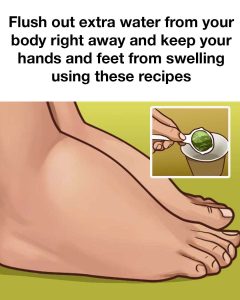
Managing Water Retention: A Simple Guide
Water retention, medically known as edema, is a condition where excess fluid builds up in the body’s tissues, leading to noticeable swelling. This can occur in various parts of the body, including the hands, feet, ankles, and legs. While water retention is often a temporary issue, it can sometimes become persistent, causing discomfort and potentially signaling an underlying health problem. For many, experiencing bloating, puffiness, and a feeling of heaviness can make daily activities more challenging.
The causes of water retention are diverse, ranging from simple factors like a high-sodium diet or hormonal fluctuations to more serious conditions such as heart, kidney, or liver disease. Despite its common nature, water retention can be a bit perplexing, as its symptoms often mimic other health issues. As a result, it’s important to understand what leads to fluid buildup and how to effectively manage it.
Fortunately, most cases of water retention can be controlled with lifestyle and dietary adjustments. Understanding how hydration, food choices, exercise, and other remedies can help alleviate symptoms is crucial to regaining comfort and preventing further fluid buildup. By exploring the causes, symptoms, and solutions for water retention, individuals can take a more proactive approach to their health, making informed choices to support their body’s natural fluid balance and overall well-being.
Common Causes of Water Retention
Several factors can lead to water retention, including:
High Sodium Intake: Consuming too much salt can cause the body to retain water.
Hormonal Changes: Hormonal fluctuations, especially during menstruation or pregnancy, can lead to temporary swelling.
Medications: Certain medications like those for high blood pressure or pain can cause fluid retention.
Lack of Physical Activity: Sitting or standing for long periods can contribute to swelling, particularly in the lower body.
Underlying Health Conditions: Heart, kidney, or liver diseases can interfere with the body’s ability to regulate fluid properly.
Symptoms of Water Retention
Symptoms of water retention include swelling, puffiness, stiffness, and a heavy feeling in affected areas. The skin might look stretched or shiny, and in severe cases, pressing on the swollen area may leave an indentation.
How Staying Hydrated Helps
Though it might seem counterintuitive, drinking enough water is essential to prevent water retention. When dehydrated, the body holds onto more water as a defense mechanism. Staying hydrated helps the kidneys flush out excess sodium and toxins, reducing fluid buildup.
Dietary Tips to Reduce Water Retention
Certain dietary changes can help manage fluid retention:
Reduce Sodium: Cut back on salty foods like processed snacks and canned goods.
Increase Potassium: Foods like bananas, avocados, and sweet potatoes help balance sodium and reduce swelling.
Eat Whole Foods: Focus on fruits, vegetables, lean proteins, and healthy fats to support fluid balance.
Foods and Drinks to Flush Out Excess Water
Some foods act as natural diuretics, helping to remove excess fluid:
Cucumbers, watermelon, and celery are hydrating and help flush out water.
Herbal teas, such as dandelion or parsley tea, have diuretic properties that promote fluid loss.
Smoothies made from ingredients like kale, pineapple, and cucumber can provide anti-inflammatory benefits and help with fluid retention.
Please Head On keep on Reading (>)
